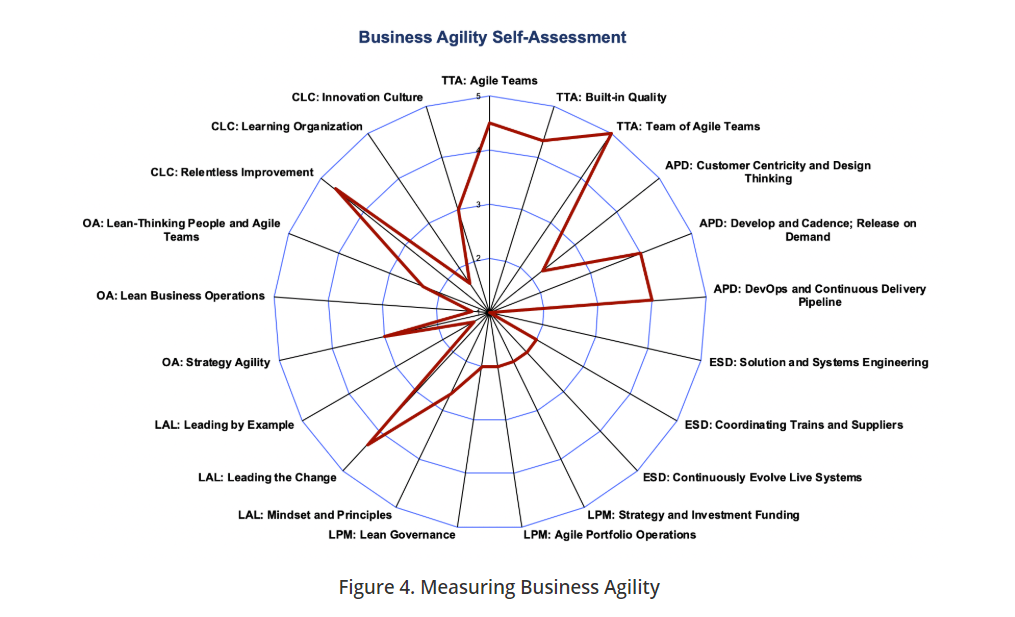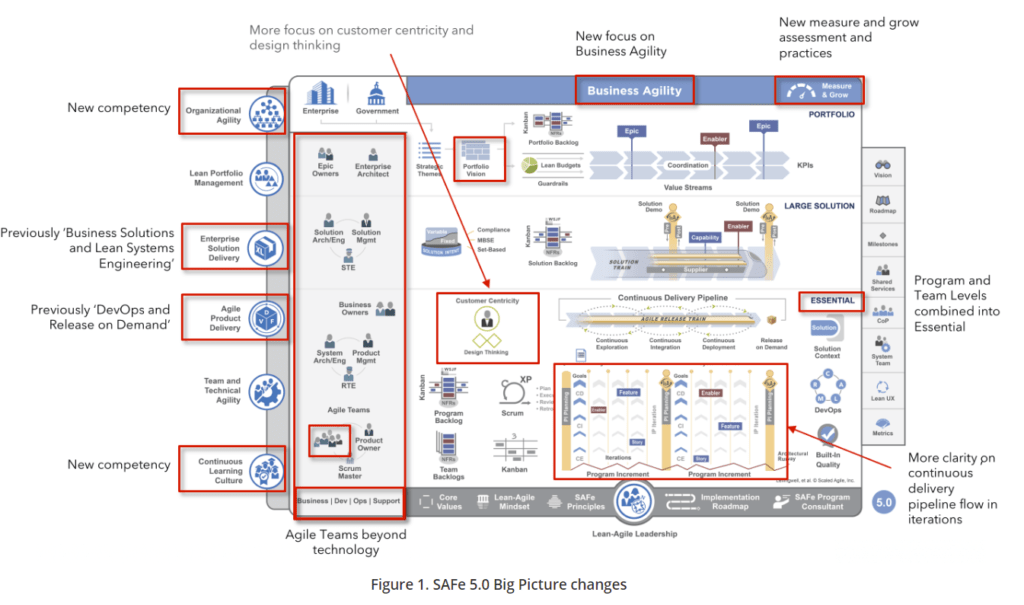Overview of What’s New and What’s Different in SAFe 5.0
OVERVIEW OF SAFe 5.0 CHANGES
At this year’s Global SAFe Summit, Scaled Agile Inc. announced a new version of the Scaled Agile Framework (SAFeTM). The new version 5.0 provides a simplified presentation of the model while emphasizing business agility, focusing on customer centricity and expanding the crucial aspect of portfolio management. In addition, SAFe has added more visibility, structure and guidance. This blog post offers an overview of some of the major changes in SAFe 5.0, which is scheduled to go live in early 2020.
REVAMPED SAFe 5.0 BIG PICTURE
For starters, as in previous updates, the SAFeTM Big Picture has been modified to reflect all the changes in the new version:
SAFe 5.0 includes a new view that is better suited to meet the demands of a global and networked economy. Change is now taking place faster than ever before. So how can we take advantage of change toward improvement and innovation? How do you make sure that organizations are intrinsically poised for change? – it’s all about Business Agility!
BUSINESS AGILITY AT THE FOREFRONT
SAFe now gives Business Agility an important place in the framework. In other words, this refers to the ability of organizations to compete and thrive in the new digital age. This requires that they quickly respond to changes in the marketplace and emerging opportunities with innovation and speed.
Just like in the House of Lean where the goal is to achieve Value, this new view highlights Business Agility as the overarching goal, being accomplished by all those competencies, and not any single one of those. It is important to note that Scaled Agile suggests that an organization cannot achieve business agility until it adopts the Portfolio level of SAFe. At this level, the ability to pivot and change your plans quickly is critical.
Everyone in the Organization Needs to be Aligned
As such, Business Agility requires that everyone involved in delivering solutions—-business and technology leaders, development, IT operations, legal, marketing, finance, support, compliance, security, and others—-use Lean and Agile practices to continually deliver innovative, high-quality products and services faster than the competition.
NEW METRICS: BUSINESS AGILITY ASSESSMENT
The SAFe framework has added a Business Agility Assessment that enables organizations to measure their level of business agility and help determine how to accelerate their growth. The assessment includes rating your organization according to different criteria and levels within each core competency. Results from this assessment, exemplified by the radar below, can act as a baseline. As such, these can help your organization determine current state and what areas to focus on where growth is needed. As well, it can help you to prioritize for maximum success on your path to business agility.

© Scaled Agile, Inc.
TWO NEW COMPETENCIES
As seen above, the new version of SAFe emphasizes agility as the driving force of change and success. Two new competencies have been added to help sustain the overarching value of Business Agility.
Organizational Agility
This competency addresses how people should think about Lean and their agile teams:
- Optimize the process
- Develop the strategy with clearer goals
- Rapidly adapt the organizations based on needs to quickly take advantage of new opportunities
This implies that all parts of the organization, beyond development teams, must get involved in thinking about the lean, agile mindset–including Finance, HR, Marketing, etc.–and reorganizing to evolve the way the business itself is organized to execute work and pivot based on external demands in the marketplace.
The second competency that has been added is the Continuous Learning culture.
This competency describes a group of values and practices that encourages individuals and organizations to continuously improve:
- Knowledge
- Competencies
- Performance
- Innovation
The goal is to bring organizations to a state where they are constantly learning, by committing to continuous improvement and promoting a culture of innovation.
Fixed mindset versus growth mindset are concepts introduced under this capability. Mindset is defined essentially as our perspective, or the way we view the world—the way our perceptions or beliefs about our abilities and qualities shape the way we operate. A fixed mindset implies that we believe that those abilities and qualities are set and cannot be changed, while the growth mindset implies that those can grow and expand.
Everyone, including leaders, all play a part in helping exemplify the behavior conducive to a growth mindset and encouraging that behavior in our teams and teams of teams. This creates a space for psychological safety. In this type of environment, there is freedom to experiment and learn from failures and successes and look for new ways to solve problems.
NEW LEVEL IN SAFE AND TWO NEW COMPETENCIES
In this new version of SAFe, the Team and Program levels are now combined into a new level, “Essential SAFe”, where Agile Release Trains are the focus: Everyone needs to be on a train to successfully deliver maximum value to the customer.
Two core competencies have been renamed and redefined:
-
- Enterprise Solution Delivery (formerly Business Solutions and Lean Systems Engineering) has been modified extensively with more meaty content focused on delivering large solutions to market, including systems and solutions engineering, coordination of trains and vendors, and more.
- Agile Product Delivery (formerly DevOps and Release on Demand) has not changed significantly, but now focuses on the way we deliver products, what are the mechanism we are using for delivery and the definition of products, with a stronger emphasis on the “agile product manager”.
RENEWED EMPHASIS ON CORE COMPETENCY OF LEAN PORTFOLIO MANAGEMENT
A lot of additional work was put into the Lean Portfolio Management core competency, to better emphasize how enterprises adopt LPM as part of their journey towards business agility. SAFe now adds a new “Portfolio Vision” area of focus. In addition, they have introduced objectives and key results (OKRs).
There are many inherent challenges in the portfolio level and organizations often struggle with getting the outcomes they had anticipated. In this case, engaging a trusted consulting partner that has experience identifying what the actual portfolio construct is in large enterprises can help lead to better business outcomes.
NEW THEMES: CUSTOMER CENTRICITY AND DESIGN THINKING
SAFe 5.0 also introduces some new themes within and around the seven core competencies of business agility. In the new Essential level of SAFe, Scaled Agile has added Customer Centricity and Design Thinking in Essential SAFe.
Customer centricity: puts the customer at the center of every decision. This theme emphasizes listening to both external and internal “customers” to better understand their needs. It’s important to make sure that you don’t get lost in the mechanics of the process, because ultimately, your “customers” determine whether value was received or not.
Design thinking: encompasses creative problem solving to help organizations decide what are the right products and solutions that customers want . It also helps to determine which are viable, feasible and sustainable for the organization to deliver them.
OH WAIT! MORE ADDITIONS! NEW PRINCIPLE – NUMBER 10: ORGANIZE AROUND VALUE
SAFe now has 10 core principles, up from 9. The new principle is Organize around Value. And that one’s a biggie. Previous versions of SAFe addressed value stream mapping and organizing teams around value. When conducting value stream mapping, the goal is to understand how your customers receive value from your products (from concept to cash), and then to build your teams and Agile Release Trainers around that stream of value.
Although this principle is significant, organizations often struggle to achieve it as it requires often substantial organizational changes.
Watch video of Ken France, SAFe Fellow, discussing Value Streams.
In conclusion, though essential and a function of continuous improvement, change is never easy. It can help to have a partner you can trust.
Read blog for 7 Steps to take when updating framework.
ANSWERS TO PRACTICAL QUESTIONS YOU MIGHT HAVE
Naturally, with any updates to the framework, come questions of compatibility and certifications. So, here are some answers to questions you might have:
-
- Will SAFe 5.0 be backward compatible with previous versions? Yes!
- As an SPC4 with SAFe 4.5 and/or SAFe 4.6 validations, do I need SAFe 5.0 validations as well? The short answer, is, well, yes!
All SAFe 4 certified members with active certifications are eligible for SAFe 5.0 upgrade path. There is one exam to upgrade all valid certifications to SAFe 5.0. You will have 2 attempts to take and pass the exam, AT NO COST TO YOU. If you pass the upgrade exam, you will get your SAFe 5.0 certification. Any additional attempts will be at the regular retake fee for exams.
HOWEVER, If you:
-
-
- Are validated to TEACH any SAFe 4 version of course, then you must go through the course delivery enablement for the SAFe 5 versions. However, you DO NOT have to retake the validation exam.
- Have NEVER taught the course, then you must take the SAFe 5 enablement and pass the exam.
-
-
-
- When will learning plans and upgrade exams for SAFe 5.0 be available?
-
Those will be available December 2019 for SPCs. For all other certified members, this will happen after the official launch in January 2020.
Stay tuned for more updates in near future!




